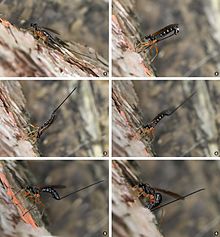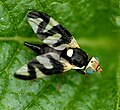Ovipositor
This article needs additional citations for verification. (October 2008) |

The ovipositor is a tube-like
Some ovipositors only retract partly when not in use, and the
In insects

The process of oviposition in Dolichomitus imperator:
1. Tapping with her antennae, the wasp listens for the vibrations that indicate a host is present
2. With the longer ovipositor, the wasp drills a hole through the bark
3. The wasp inserts the ovipositor into the cavity which contains the host larva
4. Making corrections
5-6. Depositing the eggs
The stingers of the Aculeata (wasps, hornets, bees, and ants) are ovipositors, highly modified and with associated venom glands. They are used to paralyze prey, or as defensive weapons. The penetrating sting plus venom allows the wasp to lay eggs with less risk of injury from the host. In some cases, the injection also introduces virus particles that suppress the host's immune system and prevent it from destroying the eggs.[3] However, in virtually all stinging Hymenoptera, the ovipositor is no longer used for egg-laying. An exception is the family Chrysididae, members of the Hymenoptera, in which species such as Chrysis ignita have reduced stinging apparatus and a functional ovipositor.
Fig wasp ovipositors have specialized serrated teeth to penetrate fruits, but gall wasps have either uniform teeth or no teeth on their ovipositors, meaning the morphology of the organ is related to the life history. [4]
Members of the
Ovipositors exist not only in winged insects, but also in Apterygota, where the ovipositor has an additional function in gathering the spermatophore during mating. Little is known about the egg-laying habits of these insects in the wild. [6]
In fish
Female bitterlings in the genus have an ovipositor for introducing eggs into the brood pouch of the male, who carries them until it is time to release the fry into a suitable situation in the open water.
In amphibians
The marbled newt, or Triturus marmoratus, females participate in parental investment by ovipositing their eggs. They carefully wrap them in aquatic leaves as a form of protection, scattering them throughout a pond to avoid predation. Females are not able to breathe during the oviposition process; therefore, the benefit to wrapping the eggs outweigh the cost of holding their breath. [7]
Images
-
A female fly in the family Tephritidae, with the ovipositor retracted and only the scape showing.
-
Ovipositing Mexican fruit flies showing the scapes of the extended ovipositors.
-
Female Megarhyssa laying eggs with her ovipositor.
-
Osmiasp..
-
Osmiasp..
References
- ^ Sezen, Uzay (22 July 2012). "Two ichneumon wasps competing to oviposit". Retrieved 24 July 2012.
- ^ Sezen, Uzay. "Giant ichneumon wasp ovipositing". Retrieved 15 February 2016.
- ^ "Evolutionary Genetics". www.zoology.ubc.ca.
- S2CID 90329549.
- ^ Hadwen S (1915). "A description the egg and ovipositor of Cuterebra fontinella, Clark (Cottontail Bot.)". Journal of the Entomological Society of British Columbia. 5: 88–91.
- (PDF) from the original on 2022-10-09. Retrieved 22 August 2020.
- JSTOR 1564022.
External links
 Media related to Ovipositor at Wikimedia Commons
Media related to Ovipositor at Wikimedia Commons





